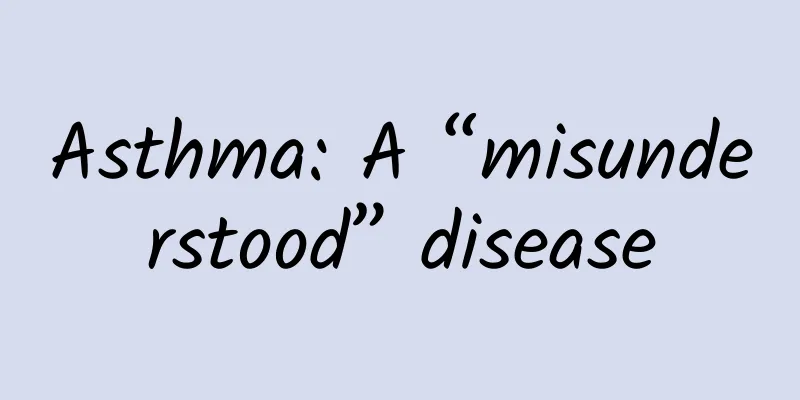Asthma: A “misunderstood” disease

|
Asthma is a common respiratory disease, but it is also a disease that has long been "misunderstood" by patients or their families. If these "misunderstandings" are not resolved, they will directly affect the treatment effect of the disease. For this reason, many patients still have repeated asthma attacks even though they have been treated, which is very troublesome! Misconception 1: Coughing without wheezing is not asthma. Many people mistakenly believe that asthma must have symptoms of wheezing, but this is not the case. There is a special type of asthma, cough variant asthma, which has chronic cough as the main or only clinical manifestation. Patients may not have obvious symptoms of wheezing or shortness of breath, but have airway hyperresponsiveness. GINA (Global Initiative for Asthma) has clearly stated that cough variant asthma is a form of asthma, and its pathophysiological changes are the same as those of asthma, namely persistent airway inflammation and airway hyperresponsiveness. Therefore, if a cough does not heal for a long time, it must be differentiated from asthma and requires professional medical diagnosis and treatment in the hospital. Misunderstanding 2: Asthma is an airway inflammation, so why can’t antibiotics be used for it? The airway inflammation of asthma refers to chronic inflammation involving multiple non-infectious cells, rather than inflammation caused by bacterial infection. Therefore, asthma cannot be treated with antibiotics, but anti-inflammatory drugs are usually used to inhibit inflammatory factors for treatment. Misconception 3: Take medicine only when symptoms occur. Asthma treatment must adhere to long-term and standardized medication. Asthma airways have long-term chronic inflammation. Long-term regular treatment can effectively improve asthma symptoms and suppress the level of airway inflammation. If you stop taking the medicine without authorization, especially if you stop treatment when the symptoms disappear, the airway inflammation will not be relieved, which will lead to worsening inflammation and repeated asthma attacks. Misconception 4: Follow-up visits are troublesome, so you don’t need to see a doctor if you don’t have any symptoms recently. Asthma conditions can change, resulting in the need to adjust medication regimens based on the condition. In order to achieve better symptom control and avoid asthma attacks, each patient must upgrade or downgrade treatment based on the situation, with the goal of finding the lowest dose that can control symptoms. Usually after the start of treatment, follow-up visits are required every 2 to 4 weeks, and then every 1 to 3 months. If an acute attack occurs, a follow-up visit is required within 1 week. Misconception 5: If you don’t have any symptoms, you don’t need to bring medicine when you go out. Here we need to remind everyone that even patients with mild symptoms are at risk of acute attacks, which can lead to serious harm. It is recommended that every asthma patient should have an asthma reliever and carry it with them to prevent asthma attacks. Commonly used relievers include: budesonide formoterol powder inhaler, terbutaline sulfate nebulizer, salbutamol sulfate, ipratropium bromide aerosol, etc. Misconception 6: Injections and medications work faster than inhaled medications. Compared with intravenous injection and oral administration, inhaled drugs reach the lungs directly through the respiratory tract after use, have a faster onset of action and better efficacy. Since less drugs enter the blood circulation, adverse reactions are relatively few. In addition, inhaled drugs are easy to carry and use, and can be inhaled and taken at any time. Misunderstanding 7: Inhaled medications contain hormones, which I heard have side effects, so it’s better to use them less. my country's authoritative guidelines point out that it is safe for patients to inhale inhaled corticosteroids within the clinically recommended dosage range. The combination of inhaled corticosteroids and bronchodilators is currently the first choice for asthma treatment. Glucocorticoids can effectively fight inflammation, while bronchodilators can quickly and long-term dilate the bronchi. They can be used as both control drugs and relieve drugs. They are currently the first choice for the treatment of asthma in patients aged 12 years and above. |
>>: Cold and cough that won’t go away? Learn about the nine respiratory tract items!
Recommend
The price of nucleic acid testing has dropped again! Is the "mixed test" with a minimum price of 13 yuan reliable?
The domestic epidemic has recurred, and the deman...
Needle-like pain in the cervix during late pregnancy
In the late pregnancy, the uterus will suddenly f...
Is phototherapy nail polish harmful to the body?
Nail polish is a common cosmetic. You can do it a...
Can I take antiparasitic drugs while breastfeeding?
You may feel stomach pain during breastfeeding, w...
Is pubic separation dangerous?
In the late stages of pregnancy, various unpredic...
Tips for pregnant women to treat itchy throats due to colds
If a patient develops an itchy throat after catch...
What to eat after uterine fibroid removal?
Once a woman is diagnosed with uterine fibroids, ...
Causes of pain in the left lower abdomen after menstruation
Since the beginning of menstruation, it has becom...
How many months of pregnancy can I have a medical abortion?
Many people encounter accidents when they are pre...
Traditional Chinese medicine treatment for fallopian tube obstruction, 3 major prescriptions are indispensable
In order to successfully conceive a healthy baby,...
Does inflammation affect menstruation?
Gynecological diseases are relatively common in w...
How long after abortion can I touch cold water?
Generally speaking, you should not touch cold wat...
Will the amount of vaginal discharge increase before ovulation?
Leucorrhea is a normal physiological phenomenon t...
The hairy part of the pubic area is itchy
Nowadays, many people find that the hairy parts o...
Signs of miscarriage during the second trimester
Pregnant women can feel the movement of the fetus...









